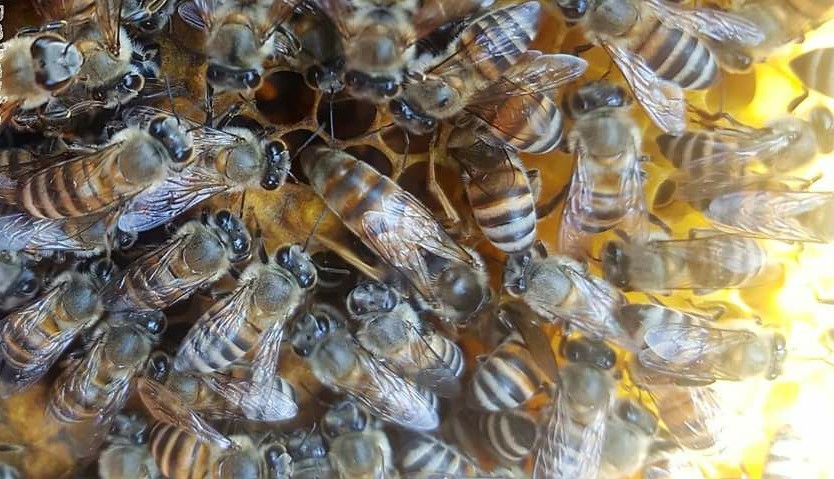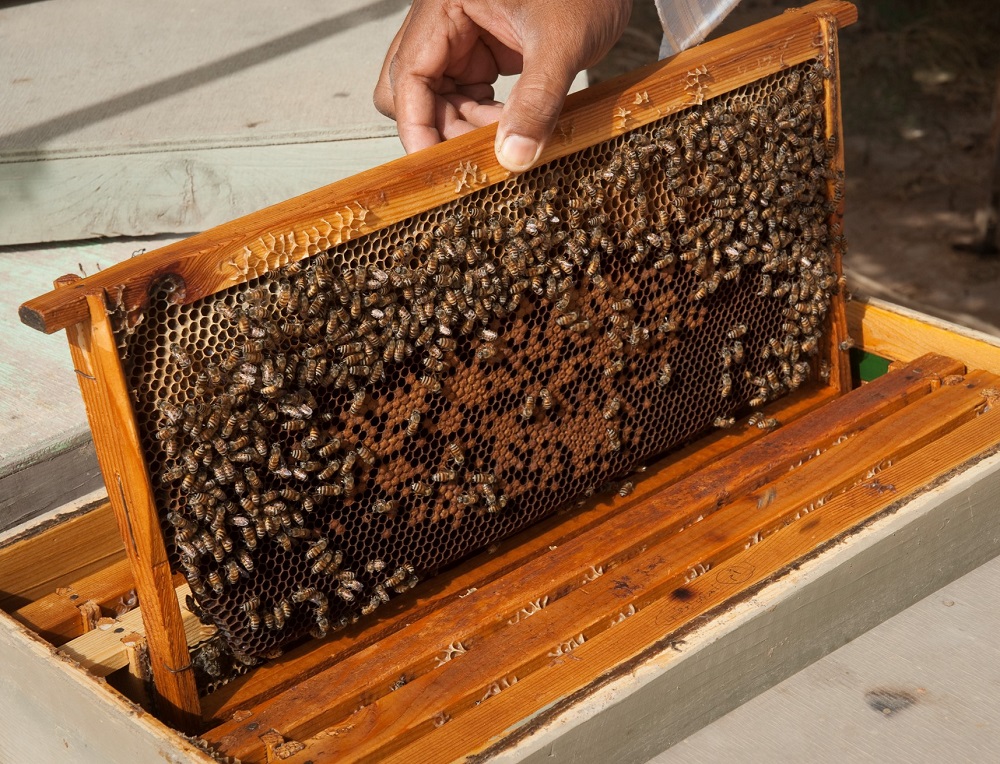By: Editorial Team (Holm Akhdar)
According to a study conducted at the University of Hadhramout, beekeeping and honey production is one of the ancient professions known in Yemen since olden times, for apiculture profession in Yemen goes back to the 10th century BC.
Historically, Yemeni apiculture was associated with the Economic prosperity of Hadhramout State at that time. Sources and statistical data indicate that the honey trade used to rank fourth in Yemen’s economies in the modern age.
Throughout the past centuries until today, Yemenis showed interest in beekeeping. As Yemeni honey is prominently known for its eminent competitive advantage and great commercial reputation, mainly the Sidr honey, produced in Wadi Do’an in Hadramout and Jardan area in Shabwa, where Do’ani and Jardani honey is considered one of the finest and most expensive types of honey in the world.

Qualities of Yemeni Honeybee Breed
Yemeni honeybee breed is one of the African honeybee subspecies, and it is one of the most small-sized breeds that live pure in mountains and valleys. It is the only subspecies that follows the global honeybee.
Colonies of Yemeni honeybees are strong and highly resistant to diseases and pests, such as Varroa jacobsoni and Wax moths, besides their quick adaptability to various circumstances when moved from one geographical area to another.
Among the qualities of the Yemeni honeybee colonies are the healthy behavior and the speed of the bees in getting rid of their dead workers’ broods. Also, Yemeni honeybees build honey hives on their own without the intervention of beekeepers, as the case is in some other countries.
The study of (Khanbash, 2019), indicates that Yemeni honeybees have a number of unique morphological qualities, which are listed below:
- Yemeni honeybees have a high adaptability to the prevailing living and nonliving environmental conditions.
- Yemeni honeybees are small in size.
- They have short tongues compared to other breeds.
- The wings and legs are relatively short, with fusiform abdomens.
- Yemeni queen bees lay eggs throughout the year, in proportion to the area of pollen grains stored in the colonies.
- Yemeni worker bees are characterized by being quiet at producing honey and active when gathering food.
- Yemeni honeybees have relative stability at spawning, colonization and pollen grains storage.
- They are characterized by the production of bright and white waxy honeycombs.
- Yemeni honeybee colonies are known for their recurrent swarming and migration.
- Yemeni honeybee build honeycombs with hexagonal eyes that are less deep and smaller in diameter than the global ones.
Yemeni honeybees’ average production of eggs ranges between 537 – 1200 eggs per day, with the brood quantity reaches its maximum rate during the months of October and November and goes down to the minimum in January.
Although, drone bees continue breeding all around the year, the presence of drone bees is noticed at the highest rate in October and November and at a lower level in the other months.


Qualities of the Yemeni Honey
Yemeni honey is uniquely privileged for it has been categorized as a honey of medicine that has a high therapeutic and nutritional value. It is characterized by its delicious taste, good flavor and dark colors. Besides, it has many other important qualities as it maintains its natural properties of pollen grains and the food of the queen bees and other bees.
Basically, beekeeping profession in Yemen, according to some reports, differs from what it is around the world, as it relies on recurrent movement about 7-8 times all over the year, and zero chemicals are used to combat pests and diseases that afflict bees, which ensures that the honey produced is fully natural.
The Yemeni honeybee breed has been endemic in Yemen for thousands of years, and it is not found anywhere else, however, during recent decades, it has been transferred and bred in several countries, including the Sultanate of Oman and the Kingdom of Saudi Arabia.
In August 2015, the Saudi Ministry of Environment Water and Agriculture tweeted that the Yemeni honeybee breed along with the Carniolan and Italian breeds are of the most famous honeybees that have been bred in the Kingdom of Saudi Arabia.
من أشهر سلالات النحل التي تربى في #المملكة : سلالة النحل اليمني، وسلالة النحل الكرنيولي، وسلالة النحل الإيطالي. pic.twitter.com/7CsVfkVYDu
— وزارة البيئة والمياه والزراعة (@MEWA_KSA) August 22, 2015
Decline of Yemeni Honey Production
Agricultural census records indicate that the number of bee colonies in Yemen has nearly tripled during the last ten years of the 20th century.
Yemeni honey is being produced in 21 Yemeni governorates, yet, the largest honey producers are the governorates of Hadramout, Shabwa, Abyan and Hodaidah, respectively.
In 2004, according to data from the Ministry of Agriculture, the number of bee colonies amounted to more than one million, and Yemen’s total production of honey was approximately 5,000 tons annually, meanwhile, the total honey exported in 2004 reached 350 tons.
However, the ongoing war and conflicts over the past six years along with floods and torrents have destroyed and washed away thousands of Yemeni beehives, and Yemeni beekeepers incurred heavy losses. The battles hindered their ability to move at night, especially the battles that took place near the bee pastures in Hodaidah, Taiz, Shabwah, and other governorates.
Furthermore, the restrictions imposed by the Saudi-led coalition on the movement of foreign trade and the closure of Yemen’s border crossings impeded the possibility of exporting products outside the country and took part in the decline of the Yemeni honey trade.
As a result, Yemeni honey production has halved, and according to recent data from the Animal Production Department (Holm Akhdar obtained a copy of it), the Yemeni honey production amounted to about 2,381 tons in 2018, which equals half of the honey quantity produced 17 years ago.
In addition, more than 90,000 beekeepers work in Yemen and as shown in the animal production data of the Ministry of Agriculture for the year 2018, the total number of Yemeni beehives stood at 1,246,562 million beehives. Meanwhile, honey production reached 2,427,750 million kilograms, and the productivity rate is approximately 1.948 kg / cell.
A study, conducted by Dr. Muhammad Saeed Khanbash from the University of Hadramout, emphasized the necessity of maintaining the Yemeni honeybee breed pure and in isolated areas. The study also asserted the need for preparing bee development programs and building queen-bee-breeding stations to provide beekeepers with queen bees and improve their production.

Types of the Yemeni Honey
Sidr Honey: It is bee-extracted from Sidr trees (Ziziphus spina- christi) and characterized as the finest type of honey, not only in Yemen, but also around the world. It is the most expensive honey as it is priced at about $ 150 per kilogram on the global market. Locally, its price ranges between 50-60 thousand Yemeni Riyal (equivalent to about $ 100).
Sumar Honey: This type of honey is bee-made from the Acacia tortilis trees, which are thorny trees and densely spread all over the Yemeni governorates, namely in Hadramout and some mountainous areas in Ibb, Dhamar, Sana’a, Taiz, and others.
Sal Honey: It is bee-made from the Athl trees (Tamarisk), and it is known for its sharp taste that causes a burning sensation in the throat and lasts for many hours, as honey sellers said.
Salam Honey: Yemeni honeybees extract this type of honey from the flowers of Salam tree (acacia ehrenbergiana), a semi-desert tree that bloom in March of every year, which is often found in Tehama, on the Red Sea coasts in western Yemen. It is also available in the mountains of Al-Mahweet governorate, which is famous for its diversity of vegetation.
White Mountain Honey: This type of honey is bee-extracted from multiple mountainous bushes and weeds that bloom in September of every year. White Mountain honey is known for its rapid freezing until it becomes like sugar.
Almarai Honey: Almarai honey is produced almost all around the year, as honeybees forage for nectar from multiple trees and flowers. This type of honey is characterized by its good quality and reasonable price.
Sources:
- Mohammad S. Khanbash, a study entitled: “The Dream of Varroa and the Yemeni Bees”, Honeybee Center, Hadramout University of Science and Technology. Yemen, June 2004.
- Mohammad Khanbash, abstract of an article “Studies on Yemeni Bees”, Arab Scientific Community Organization, May, 2019.
- Statistics Yearbook, Ministry of Agriculture and Irrigation, Yemen, 2018.
- The Blog of Yemeni Honey Store.
